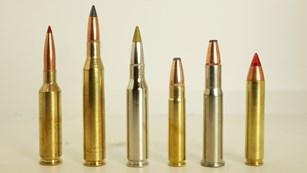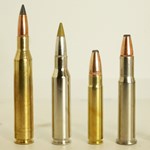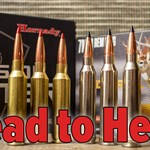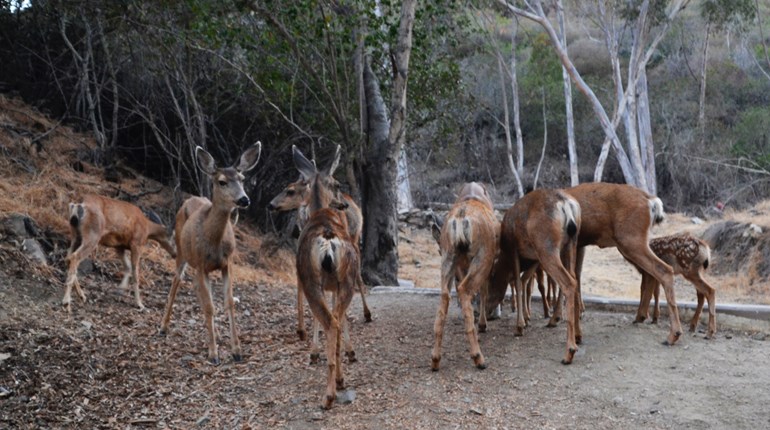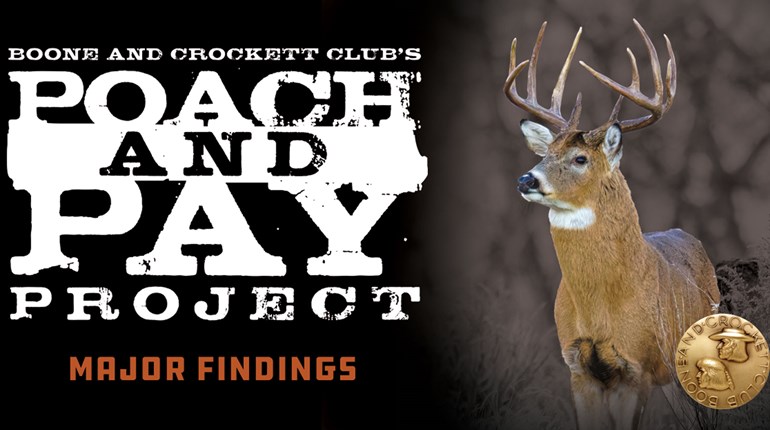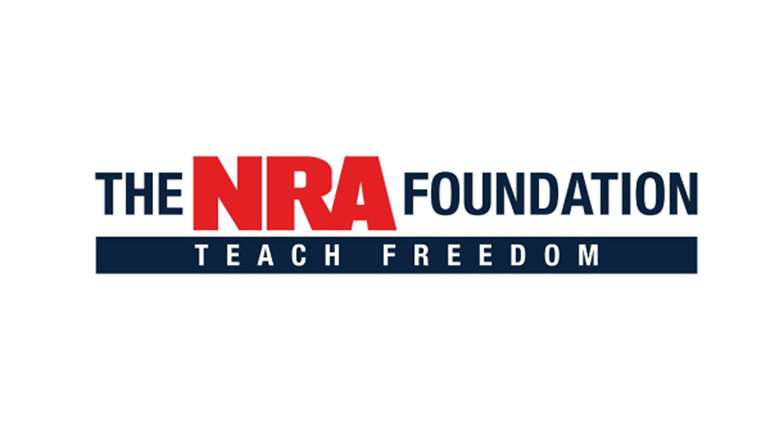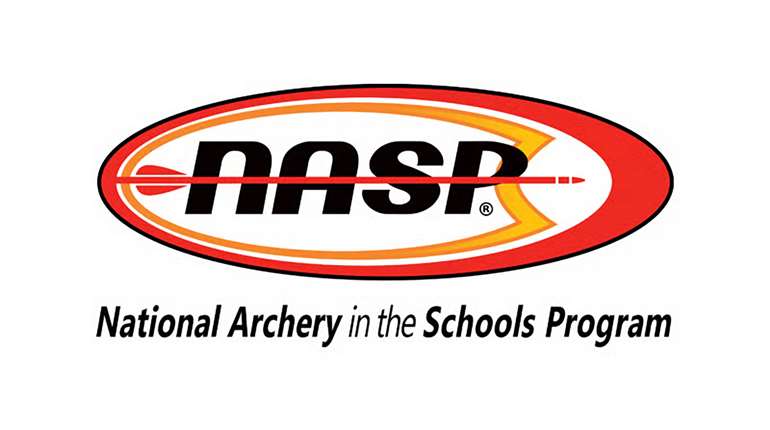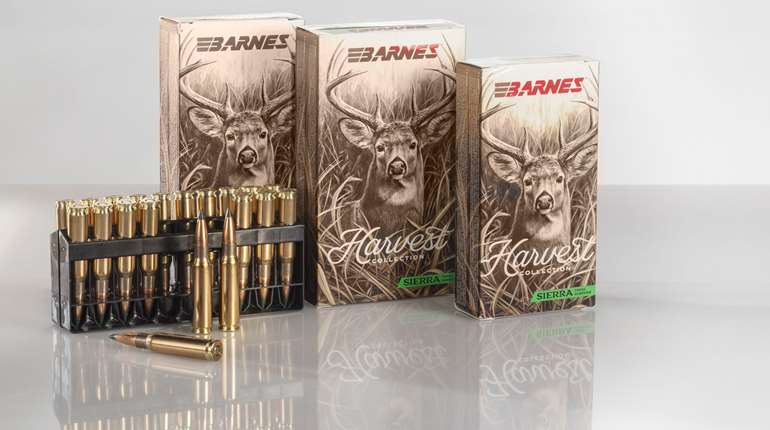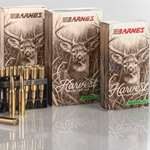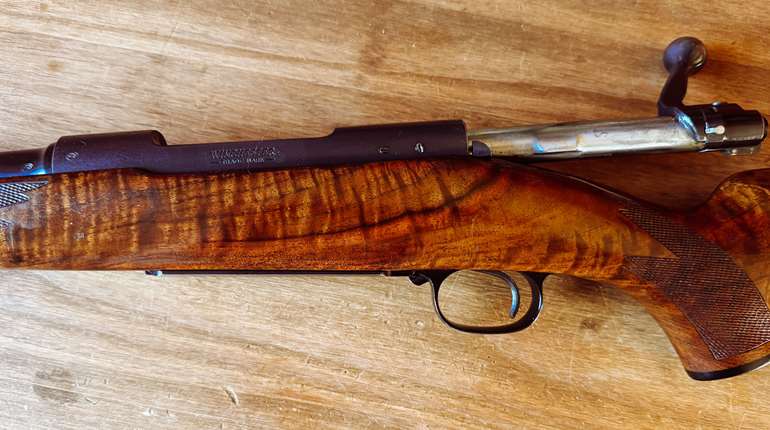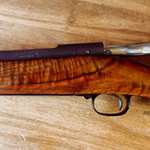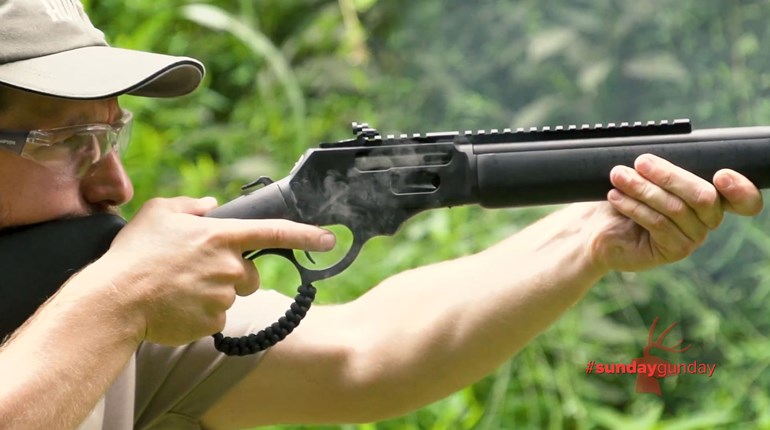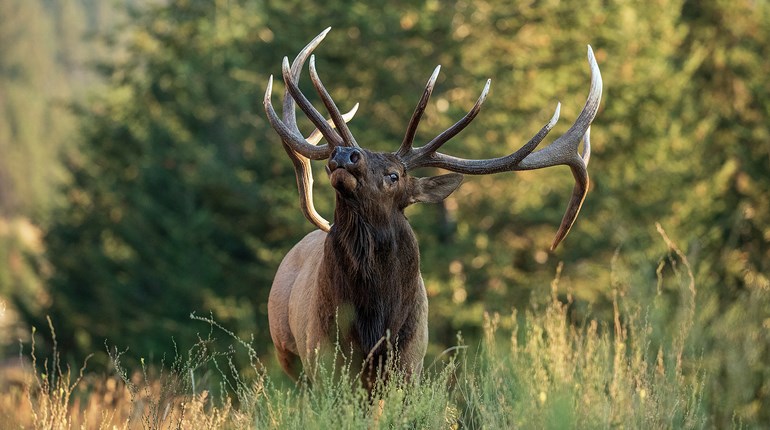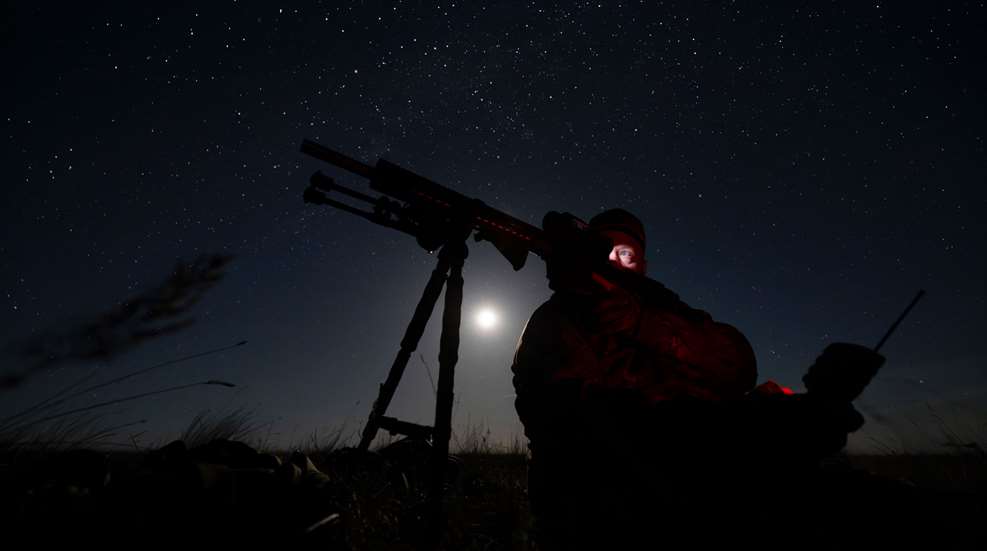
I read it all the time on social media: “Hunting with high-tech gear is so, so easy! You show up and shoot. Hell, it’s really not even hunting. It’s just target practice!” I wish someone had told my left knee about this all-so-easy hunting. At that moment, the only “shooting” going on was the pain pulsing through said knee.
True to the high-tech theme, our hunting guide this night launched a drone into the darkness outfitted with tech including a thermal camera. Up went the drone and our host Jim and I peered at the small tablet and the images sent back via the drone camera.

The author’s guide, Jim, marshaled a night-flying, thermal-equipped drone to scout and transmit live images for viewing on a small screen in the field.
“Those are cattle,” Jim explained, motioning to the small black rectangles on the screen. “More cattle,” he added as the drone swung out farther. “Those smaller ones? Deer.”
I was night hog hunting at the invitation of Armasight, one of the nation’s top manufacturers of thermal and night-vision gear. We were in Oklahoma, south of Durant and less than a mile from the Red River bordering neighbor state Texas. It was a little before midnight, and the moon was oh so bright overhead.
A real pro with his thermal drone, Jim eventually spotted a half-dozen black spots of the correct size that moved the way hogs move. They were several fields over in a large open space surrounded by bands of trees, maybe a half-mile away.
Easy, right? Jump into the side-by-side, drive as close as we can get, unload and hike into and through the tree line and sneak up on some unsuspecting hogs. Except the line of trees we made our way into was a regular mine field of downed branches, deep holes and random strands of barbed wire. I stumbled through some ground clutter and branches only to hit one of those strands mid-shin of my right leg. That dropped me to my left knee, right onto a nice, fist-sized rock. I limped through the rest of the tree line and into the field, already behind the other three hunters. Damn. I sped up, sweating, knee aching, but I caught up to Jim and fellow hunter Darren by the time we got to the far side of the field where Jim had spotted the hogs. One problem: the hogs had split.
“They must’ve moved through the trees and into that big field,” said Jim as he waved his arm into the night sky, signaling an area far from us. “It’s about a 30-minute walk from here. You guys up for that?”
No. But what the heck else was I going to do?

A Pair of Thermals
This was night three of four I spent testing Armasight’s Contractor 640 thermal riflescope sporting a 50mm objective lens, and its handy, much smaller Sidekick 320 mini-thermal monocular.

The Contractor 640 is Armasight’s top-of-the-line thermal comprised of a 640 thermal sensor and a long list of features including a one-shot zeroing system, multiple color pallets and reticle options, as well as on-board photo and video capability. The Contractor 640 created detailed images even when the humidity was high, humidity being an environmental factor that can and will distort thermal efficiency. That moisture-filled air was what I hunted in the first two nights in East Texas. While the heat and 80 percent humidity had me sweating freely, the Contractor’s sensor had no problem sorting out and defining the various heat signatures in the night.

That first night had me and Darren Jones, at the time product manager for Armasight, parking our ATV at the edge of a large field and hiking a few hundred yards over a ranch road to a deer feeder. Hogs were hitting this feeder regularly, the ranch owner told us. The only real problem that night was the full moon overhead, which cast a bright light. Jones and I made it through that ranch road and still had a couple hundred yards to go, so we hugged the tree shadows so we wouldn’t get spotted. Some people think hogs are essentially blind at night. And while it’s true they don’t have comparable vision to a sharp-eyed whitetail, I’ve been busted by hogs in the moonlight more than once. They may not have known exactly what I was, but I sure wasn’t supposed to be there, and they reacted by running in the opposite direction.
Jones and I made it to the feeder area and set up in the brush about a hundred yards away. About 20 minutes later, we heard the grunts and squeals of an approaching sounder.
Through my Contractor, I saw the heads of the smaller hogs as they rushed toward the feeder, eager and hungry, while the larger, more cautious hogs of the sounder took their time.
Big Momma hog eased out of the trees and made for the feeder, hit a pocket of corn and put her head to the ground, presenting a nice broadside shot, which I took. She hit the ground, but only for a couple of seconds. Then she was up and running despite a solid shot into her lung region. My color palette was set on red hot. I tracked her through the Contractor. She ran straight away then made a turn to the right and I fired, the thermal’s crosshairs a half-foot beyond her snout. The Barnes bullet impacted just beneath her ear, and she made an amazing cartwheel into the air then crumpled to the ground. I videoed the shots thanks to the Contractor’s on-board recording capability.

Ups, Downs
Night hunt No. 2 in East Texas was slow, the hogs being content to lay up, it seemed. We drove thickly wooded areas and large fields scanning the darkness, but all we spotted were a pair of hogs around 1 a.m. They disappeared before we could get into shooting range.
The next night had Jones and me in Oklahoma hunting with Jim.
Actually, I started that night’s hunt wearing a helmet rigged with the Sidekick Mini-thermal on one side and an Armasight night-vision unit on the other. I’ve used night vision on helmets many times, but this was the first pairing with a thermal and it took some time for me to get comfortable with the rig. I soon realized the advantage: The night vision provided a nice sight picture while walking and driving as the Sidekick spotted the heat signatures of the hogs.
Driving into an ag field, we’d scared up three pigs and not of the little variety. They zoomed off and into a large, brushy depression and apparently thought they were safe there. We stopped the side-by-side and put on a stalk. Whatever fear they’d had at the sight of the vehicle apparently disappeared once they got to the low spot, and through the Sidekick I saw them feeding.
Standing at the edge of the depression, but still in the field itself because it was higher ground, I dropped to one knee for stability. I flipped up the Sidekick and night vision unit. I lined up the Contractor’s reticle on one hog; Jones did the same on another and we began firing. A half-dozen rounds later, we had a pair of stout young boars on the ground.
Admittedly, that was all fairly easy. But it took another three hours for us to spot any more hogs, which Jim did with the thermal-rigged drone.

By the looks of the above, the reticle of the Armasight Contractor 640 thermal riflescope settled on many hogs in four nights in the Red River region.
Hill and Gully Hunters
The half-hour hike to the far field turned out to be more like 45 minutes, but at least the movement and the sweating loosened my knee and the walking got easier. Though it was not quicker. I lagged behind the others a good bit, though I could clearly see them in the moonlight, upright ghosts drifting ahead of me.
At least they had the decency to halt at the edge of the field and wait for me to catch up.
Actually, Jim’s “field” was a huge swath of steep hills covered in shin-high grass, the hills cut by rocky gullies. We scanned the huge open area ahead of us. All I saw through the Sidekick 320 were hills and gullies.
“Got something,” Jim said, as he scanned with a thermal rig. “Let’s get up on this hill and I think we’ll have a shot.”
We got to the top and saw Jim was right: half a dozen hogs were walking through the gully between our hill and the next one over, their backs visible through my Sidekick. We set up the tripods we’d been carrying and laid our rifles in the yokes. The hogs turned slightly and began climbing upslope and away from us. “Pick out a hog,” Jim whispered. “Get ready.”
The hogs were probably 150 yards away when Jim did the “one, two, three” countdown and our shooting began. I actually wasn’t able to get onto a hog before the first round fired and as soon as that shot was sent, the hogs scattered uphill, minus two that hit the ground. I tried to get onto a zooming, twisting pig but couldn’t as the rifles to the left of me banged away. My fellow hunters ended up dropping three pigs total. Me? I hadn’t squeezed off a single shot. Jim and Darren were high-fiving each other. I wasn’t even bothered that I didn’t get a shot. That’s how it goes at times. It’s part of the hunt.
Jim said he was going to get the side-by-side. He said he could get it and return for me or I could walk with him: What did I want to do? “I’ll wait for you,” I said. “Thanks, man.” Then I sat right down and dug in my backpack for a bottle of water, suddenly very thirsty, a carpet of brilliant Oklahoma stars twinkling overhead.

Guns and Gear for Night Hogs
The Contractor 640 Thermal Weapons Sight from Armasight is available in three different objective lens sizes: 35, 50 and 75mm. All are built around Armasight’s proprietary ArmaCore 12 micron thermal core. That core provided heat detection capabilities out to just over 2,000 yards in my unit. My scope’s on-board image processing created very detailed images, too, not just general outlines of hogs and coyotes and other heat sources.
The turret control system quickly and intuitively accessed the unit’s menus, allowing me to switch palette and reticle colors to better match environmental conditions. Like all Armasight products, the Contractor is reliable for use in all weather conditions.
The Sidekick 320 Mini Thermal Monocular is a handheld or helmet-mounted unit. Small but packing impressive features like the ArmaCore 320×240 12 micron thermal core. I used the 320 over the course of two nights of hunting and was able to spot and ID hogs at 300 yards even in high humidity. It featured multiple color palettes, an Image Detail Enhancement function and internal video and photo recording ability. Mine ran for many, many hours on a single CR123 battery. armasight.com

My rifle was my FM-15 223 Rifle Gen. II from Foxtrot Mike, at the time available exclusively from Brownells. Unlike standard ARs, the FM-15 featured a forward placed, non-reciprocating charging handle along the left side of the rifle’s 16-inch barrel. The FM-15 also sported a Magpul Zhukov folding stock for easier transport. As a side charger, the rifle didn’t have a buffer tube but was still gas operated; the charging handle rode above a direct-impingement, mid-length gas system, similar to a standard AR-15. brownells.com
I mounted AB Suppressor’s Raptor 7.62 suppressor to my rifle, and it reduced muzzle blast to a comfortable level without hearing protection. It was also key to me and the other hunters keeping close contact even when the shooting got heavy. absuppressor.com
Hogs are tough beasts so I opted for Barnes VOR-TX ammunition in 5.56x45 NATO, loaded with 70-grain all-copper TSX BT bullets. Those bullets expanded nicely into four cutting petals and dumped all their energy into hogs. barnesbullets.com


